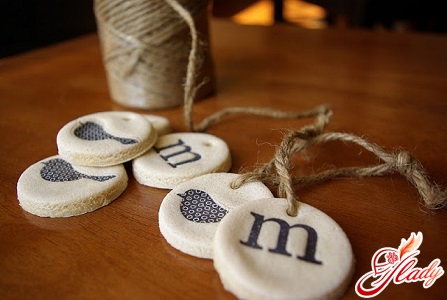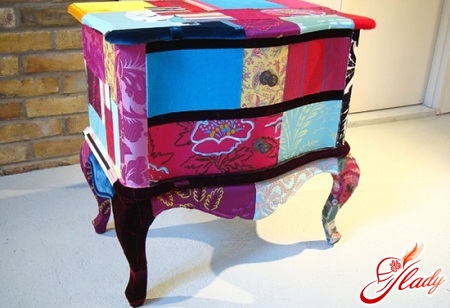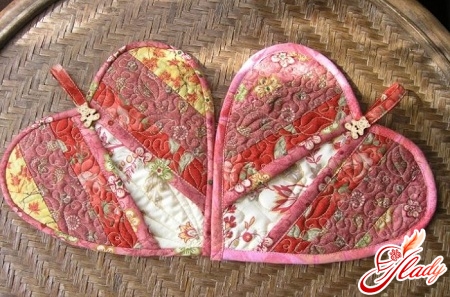 Decorating your home is probably something everyone enjoyswoman. And when it comes to the kitchen, the imagination is simply inexhaustible. And you can always use your own handicraft skills to decorate the kitchen. For example, sewing kitchen potholders. Such cute little things can become an excellent decorative ornament, a touching and useful gift, or even serve practically. Potholders made in the patchwork style look very interesting and “cozy”. The products are small in size, and even the smallest scraps can be used to make them. So patchwork sewing in any of its variations is applicable for sewing kitchen potholders. They can be quilted (made using the quilting technique), can be round and rectangular (traditional patchwork), or even made in the form of mittens or in the crazy patchwork style. Let's see how to implement all this in practice.
Decorating your home is probably something everyone enjoyswoman. And when it comes to the kitchen, the imagination is simply inexhaustible. And you can always use your own handicraft skills to decorate the kitchen. For example, sewing kitchen potholders. Such cute little things can become an excellent decorative ornament, a touching and useful gift, or even serve practically. Potholders made in the patchwork style look very interesting and “cozy”. The products are small in size, and even the smallest scraps can be used to make them. So patchwork sewing in any of its variations is applicable for sewing kitchen potholders. They can be quilted (made using the quilting technique), can be round and rectangular (traditional patchwork), or even made in the form of mittens or in the crazy patchwork style. Let's see how to implement all this in practice.
A simple square patchwork patchwork
The easiest way to use patchwork is tomaking square potholders. You can choose a well-known pattern, or you can come up with your own ornament, focusing on the number and color of the patches. Let's try to make the simplest patchwork potholder from two types of fabric. For this, we will need eight square patches with a side of ten centimeters and a bias tape for edging. You can take a ready-made tape, use a thin satin ribbon for this purpose, or cut out a bias tape from any suitable fabric. And for relief, make a lining between the potholder panels from ordinary or thermal batting. Naturally, first the material must be wetted or washed, dried and ironed. Then we cut out the patches and fold them in pairs (two different pieces) with the front sides facing each other. Now we sew each pair of patches and iron the seams. After that, we sew two pairs, making sure that the squares are staggered, and iron the seams again. We got two small square canvases consisting of four patches (each). We take these canvases and fold them with the wrong sides together, and between the canvases we put a lining of the size of the potholder. Then we pin all the layers together and make a stitch along the lines of the junction of the patches (we make a stitch seam to seam). Now all that remains is to sew the edges with a facing, the length of which should be equal to the length of all sides of the potholder plus seven to ten centimeters for the loop. We start sewing from one of the corners of the potholder, evenly laying the facing along the entire perimeter of the square. We stitch the remaining “tail” along the edge of the facing and wrap it into a loop, the end of which we sew by hand.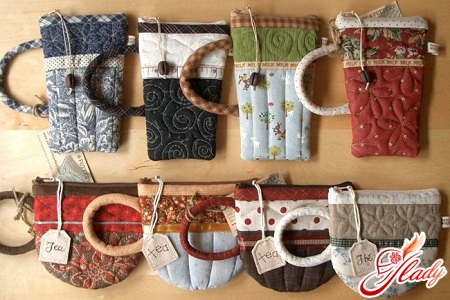
Quilted square pothook
Patchwork doesn't have to bebe made from scraps. There is a very interesting technique called quilting. This is stitching or American patchwork sewing. Try making these kitchen potholders, sewn from whole pieces of fabric and decorated with voluminous stitching. For one potholder, we will need two square scraps of the same size, batting for the lining and binding for the edging. We start sewing by cutting out squares of the same size from the fabric and batting. We put the first scrap on the table with the wrong side up, put the batting on it, and place the second scrap on top with the right side up. We pin our “sandwich” and start stitching. If you are not confident in your abilities, then you can, firstly, apply stitch lines to the fabric with a pencil (or soap), and secondly, you can make a light basting along these lines. Just keep in mind that the basting threads can get stuck in the machine stitch. So, let's make a stitch. It can be a simple lattice (straight or oblique). It can be smooth curved lines, located as we like (or as it turns out), or you can quilt a specific pattern (flowers, butterflies, hearts, suns, maple leaves). If you are using a checkered fabric, then make a stitch along the check. If the fabric has a large printed pattern, then lay the stitch along its contour. Any straight or figured stitch will look good on plain fabric. Now we process the edges of the potholder with a bias tape and make a loop. And for a more effective look of the product, you can round the corners of our potholder in the patchwork style, simply cutting off the excess fabric with scissors, and then sewing the edges with a bias tape. In this case, it is better to take a ready-made bias tape or cut it out of a contrasting fabric.
Heart-shaped potholder
A great way to use patchwork is notnot only to decorate your own kitchen, but also to make a gift for Valentine's Day. You will say that such patchwork valentines are not suitable as a gift for your beloved man? But, firstly, you can give a heart-shaped potholder not only to a man, and secondly, many of them enjoy cooking, spending a lot of time in the kitchen. So we sew potholders in the shape of a heart, using the popular patchwork sewing. We choose fabrics of two colors. We will need plain chintz or satin and fabric with a pattern (checkered, flowers, polka dots or something else). It is preferable to use fabrics of red, pink, orange, lilac tones for such hearts. You will also need threads to match the fabric, cardboard for the template, pins, batting for the lining and piping for edging. We cut out a heart-shaped template from cardboard, put it on the fabric and cut out two parts of different colors. Now we start sewing: fold the fabrics with the wrong sides together, pin them and cut them into three parts along the inclined straight lines that cut off the side parts of the heart. As a result, the middle part of the patchwork heart should be in the form of a trapezoid with figured ends (one end is the lower corner of the heart, the second is the upper notch-check). After that, we swap the centers of the hearts and get two panels in which the middle part will be made of one fabric, and the side ones of another. Now we sew the patches together. First, fold the middle patch with one of the side pieces with the right sides together, aligning the edges of the cut, and make a connecting line, and then sew the third part of the heart in the same way. Due to the seam allowances, the edges will be a little uneven, but this is not a problem: just trim the outline of the heart with scissors. Now cut out a heart for the lining according to the template and fold all the layers of the future patchwork potholder, securing them with pins. After that, you need to stitch the layers along the contour of the heart, stepping back five millimeters from the edge, and process the potholder with a piping. The loop can be made from the same piping or from tape, hiding its ends between the layers of the lining, but this must be done before stitching the layers and sewing on the piping.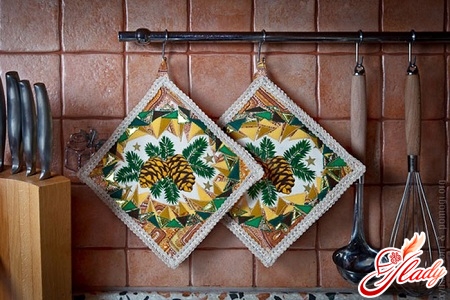
Potholder - spinner
No, no, they won't spin at all.Here, patchwork is used as a technique for creating a pattern from pre-sewn strips of fabric. We will make the patches triangular, and the potholder itself will be hexagonal with a pinwheel pattern. So, to make such a patchwork potholder, we need fabric of two colors: plain and printed. From these fabrics, we cut strips about eight centimeters wide (or smaller, calculating their width from the height of the triangular patch). Now fold the strips with the right sides together, stitch them along one edge, making an allowance of five millimeters, and iron the seam. Then, using a square ruler (sixty degree angle), cut out triangles. First, we put the corner, aligning the top with the upper edge of the strip, then turn it over and align the top with the lower edge of the strip. As a result, we will get two-color triangle patches with a variegated and plain upper part. We will need twelve of these patches: six for each side of the patchwork potholder. Sort the patches into six identical triangles. Next, we need to fold the patches (with a single-color top), forming hexagonal blocks. We do this as follows. Place the patch with the top up. To the right of it, place a triangle with a single-color top to the right and up. Apply the patch to it with a single-color top to the right and down. Place a triangle (aligning the bases) with the top to the left and up to the first patch from below, place the patch next to it with the top to the left and down, and place the last triangle with the top down. As a result, a pattern in the form of a colorful pinwheel has formed on our block. Now we sew the patches: first the triangles of the upper part of the block, then the triangles of the lower part, and then stitch both halves along the long sides. We press the seams apart. We do the same with the second batch of patches, sewing a block with a single-color pinwheel pattern. Now we cut out a lining from batting in the shape of the potholder and fold all the layers in the following order: first we put the batting, and then one piece face up on it, and then the second piece face down on it. We pin the layers (so that they do not shift) and stitch them along the perimeter of the potholder, leaving an unstitched area for turning the product inside out. Now we remove the pins, trim the allowances almost to the seam, make notches in the corners and turn the potholder inside out. We iron it, insert a loop between the layers in the unstitched area and stitch it by hand. Starting from the center of the potholder, we make a stitch seam to seam, and if desired, we put a decorative stitch along the edge of our patchwork potholder.
Potholders — mittens
You can use patchwork as welltechnique for making traditional mitten-shaped potholders. First, assemble the patchwork fabric using the traditional technique. Start sewing by cutting out small square patches, which we assemble into strips, and then sew the strips into a single piece of fabric and iron the seams. Now cut out a cardboard template in the shape of a mitten and cut out one piece of patchwork fabric, two pieces of batting, and three pieces of a single piece of fabric for the back sides of the potholder. Start sewing the halves of the mitten. For the back side, fold the plain piece face down, batting, and then the patchwork piece face up onto it. Pin the layers and stitch along the contour of the mitten with a small allowance. Now sew the piece for the inside of the mitten in exactly the same way from plain patterns and batting. After that, in places of the rounded contour, we make cuts-notches on the allowances, and in the place of transition to the thumb, we carefully cut out the allowance. Next, we fold both blanks with the front sides and sew them along the contour of the mitten, leaving the wrist open. After that, we turn the mitten inside out and process the open edge with a piping or tape, making a loop from its tail. That's all the patchwork sewing for a patchwork-style potholder. Actually, patchwork sewing and quilting are the best suited for making potholders. Potholders should be dense and thick to protect your hand from hot frying pans and pots. And multi-layer patchwork fabric will cope with this task perfectly. So sewing potholders can become not only a pleasant pastime, but also a profitable occupation. On the one hand, you find a use for unnecessary fabric scraps, and on the other, you get a useful and practical thing for the kitchen. And if sewing is your hobby, then try to apply your skills in making useful and cute kitchen potholders. By the way, beginner craftswomen can successfully master patchwork sewing on such small items. Good luck to you and creative success! We recommend reading:






